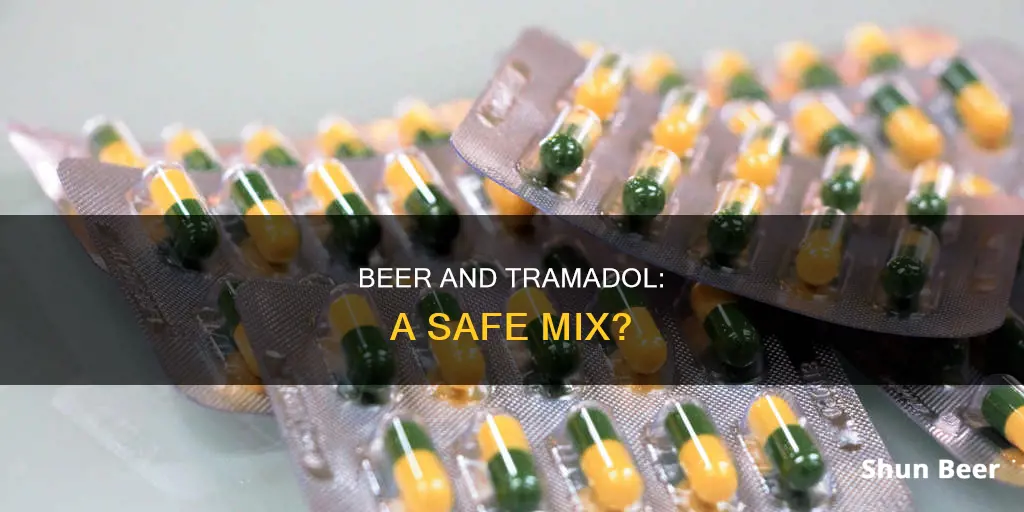
Drinking beer while taking tramadol is not recommended. Both substances are central nervous system depressants, which means they can slow down brain function when combined. This can lead to a range of side effects, including problems with concentration, cognitive impairment, poor judgement, and coordination difficulties. More severe consequences of mixing the two include respiratory depression, overdose, and even death.
| Characteristics | Values |
|---|---|
| Should you drink beer while taking tramadol? | No |
| Why? | Both are central nervous system depressants, which can lead to additive side effects and an increased risk of overdose and death. |
| What are the side effects of mixing tramadol and alcohol? | Drowsiness, dizziness, reduced coordination, lowered blood pressure, decreased heart rate, poor decision-making, loss of consciousness, seizures, respiratory depression, hypothermia, hypertension, kidney damage, stroke, psychosis, anxiety, delusions, mania, paranoia, liver damage, circulatory problems, memory loss, hallucinations, convulsions |
| What are the signs of a tramadol overdose? | Loss of consciousness, seizure activity, slow breathing, shallow breaths, pale or blue skin colour, cold and sweaty skin, excessive sleepiness, pinpoint pupils, loss of muscle control, slowed heart rate, loss of consciousness, cardiovascular collapse, purple or blue lips and fingernails |
What You'll Learn

Tramadol and alcohol are central nervous system depressants
Combining tramadol and alcohol can also lead to a dangerous level of tolerance to tramadol, pushing the user towards higher doses and a potential substance misuse problem. This combination can also trigger the rapid release of tramadol in the body, especially if the user is on an extended-release formulation, heightening the risk of overdose.
The liver damage that can result from mixing tramadol and alcohol is another significant concern. The liver works hard to process substances like tramadol and alcohol, but combining them overburdens this vital organ, increasing the risk of severe damage.
Additionally, mixing tramadol and alcohol can cause seizures, respiratory depression, hypothermia, hypertension, kidney damage, and stroke. It can also increase the risk of psychosis, anxiety, delusions, mania, and paranoia.
It is important to note that there is no safe amount of alcohol to consume while on tramadol. Even small amounts of alcohol can lead to dangerous health complications when mixed with tramadol. Therefore, it is crucial to avoid alcohol consumption entirely while taking tramadol to avoid the potential dangers of mixing the two substances.
Asking for Beer Outside Gas Stations: Does It Work?
You may want to see also

Mixing the two can lead to a fatal overdose
Mixing tramadol and alcohol can lead to a fatal overdose. Both substances are central nervous system depressants, which means they can slow down brain function when combined. This can lead to a range of side effects, including problems with concentration, cognitive impairment, impaired judgement, and coordination difficulties. More severe consequences can also occur, such as respiratory depression, unconsciousness, coma, and even death.
The combination of tramadol and alcohol can also increase the risk of addiction and long-term organ damage, including liver, kidney, and brain damage. The risk of a fatal overdose is further elevated when tramadol is used with other central nervous system depressants, including opioids, benzodiazepines, and street drugs. This can lead to extreme sedation, respiratory depression, coma, and death.
The dangers of mixing tramadol and alcohol are compounded by the fact that alcohol can trigger the rapid release of tramadol in the system, especially if an extended-release formulation is being used. This increases the risk of overdose. Additionally, alcohol can numb pain signals, masking underlying health issues that may require medical attention. Over time, alcohol can also exacerbate pain conditions and contribute to other health problems.
It is crucial to avoid alcohol consumption entirely while taking tramadol to prevent dangerous health complications. Even small amounts of alcohol can lead to extremely dangerous health complications when mixed with tramadol. The line between safety and danger is thin, and erring on the side of caution is always best. If you are addicted to tramadol and/or alcohol, treatment options include inpatient care, detoxification, and behavioural therapies.
Chilling Beer Fast: How Do Chiller Sticks Work?
You may want to see also

Side effects include psychosis, anxiety, delusions, mania, paranoia, and cognitive impairment
Mixing tramadol and alcohol can lead to a range of severe side effects, including psychosis, anxiety, delusions, mania, paranoia, and cognitive impairment. These side effects arise due to the combined impact of both substances on the central nervous system.
Tramadol is an opioid pain medication that acts on certain nerve receptors in the brain, altering the way the brain perceives and responds to pain signals. When taken as prescribed, common side effects include nausea, dizziness, and vomiting. However, when mixed with alcohol, the side effects can become much more severe.
Alcohol and tramadol are both central nervous system depressants, which means they can slow down brain function when combined. This interaction can lead to increased sedation, respiratory depression, and even a deadly overdose. The risk of a fatal overdose is heightened when tramadol is combined with other central nervous system depressants, including alcohol.
The combination of tramadol and alcohol can also increase the risk of psychosis, anxiety, delusions, mania, and paranoia. These mental health effects can be severe and may lead to impaired judgment, mood swings, and, in extreme cases, suicidal thoughts. The impact of this mixture on mental health and cognitive functions is profound, and driving or operating machinery under its influence is extremely dangerous.
In addition to the immediate health consequences, mixing tramadol and alcohol can also lead to the development of a substance use disorder. The combined effects of these substances on the central nervous system enhance their addictive potential, making it more challenging to break free from addiction.
To avoid these severe side effects and health risks, it is crucial to abstain from alcohol consumption while taking tramadol. Consulting a healthcare professional is essential to ensure the safe use of these substances and to address any concerns regarding addiction or dependence.
Post-Massage Beer: Is It Safe to Drink Alcohol?
You may want to see also

Tramadol and alcohol can cause long-term organ damage
Tramadol and alcohol are a dangerous duo that can wreak havoc on your body, causing long-term organ damage and even death. Here's why you should never mix them:
The Dangers of Mixing Tramadol and Alcohol
Tramadol is a potent opioid medication often prescribed to manage moderate to severe pain, especially in chronic conditions. It works by altering how the brain perceives and responds to pain messages, providing much-needed relief to patients. However, when mixed with alcohol, it becomes a recipe for disaster.
Both tramadol and alcohol are central nervous system depressants. This means that when combined, their effects are amplified, leading to a range of dangerous side effects. The mix can cause extreme sedation, respiratory depression (slowed or stopped breathing), cognitive impairment, poor coordination, and even coma. The risk of overdose and death is significantly increased, as highlighted by the FDA's Black Box Warning.
Long-Term Organ Damage
The dangers of mixing tramadol and alcohol go beyond the immediate side effects. There is a clear increase in the risk of long-term organ damage when these substances are used together. The liver, in particular, is at risk. The liver works hard to process substances like tramadol and alcohol, but when they are combined, it becomes overburdened, increasing the chances of severe liver damage or even failure.
Additionally, the combination can lead to kidney damage and long-term brain damage due to severe oxygen deprivation. The brain is extremely sensitive to oxygen deprivation, and even a short period of respiratory depression caused by the tramadol-alcohol mix can have lasting consequences.
Increased Risk of Addiction
Mixing tramadol and alcohol not only poses immediate health risks but also increases the risk of developing an addiction to one or both substances. The combined effects of these substances on the central nervous system enhance their addictive potential, making it easier to fall into a cycle of substance misuse.
Safe Detox and Treatment
Quitting alcohol and tramadol simultaneously can be challenging and may lead to severe withdrawal symptoms. Seeking professional help is crucial for a safe and successful detox. Medical supervision ensures that you are supported and monitored throughout the withdrawal process, and medications can be provided to manage discomfort and reduce the risk of complications.
Inpatient treatment is often recommended for dual addictions as it offers a structured environment and comprehensive care, addressing the complex needs of individuals struggling with both substances.
Tramadol and alcohol are a dangerous combination that can cause severe side effects and long-term organ damage. The mix impairs your central nervous system, increases the risk of addiction, and poses a serious threat to your liver, kidneys, and brain. If you find yourself struggling with a tramadol and alcohol addiction, reach out for professional help immediately to get started on the road to recovery.
Beer and Tramadol: A Risky Mix?
You may want to see also

Mixing the two can lead to addiction
Mixing alcohol and tramadol can have serious health consequences, including an increased risk of addiction. Both substances are central nervous system depressants, which means they can slow down brain function when combined. This can lead to a range of side effects, including problems with concentration, cognitive impairment, poor judgement, and coordination difficulties.
The combination of alcohol and tramadol can also increase the risk of psychosis, anxiety, delusions, mania, paranoia, and serotonin syndrome. The risk of developing serotonin syndrome is higher when taking multiple medications or misusing tramadol. Some symptoms of serotonin syndrome include agitation, confusion, abnormal eye movements, fever, diarrhea, muscle spasms, shivering, and tremors.
The mix of alcohol and tramadol can also lead to a false sense of security, as it makes you feel more energetic and increases your overall sense of well-being. This can lure you into thinking you can continue to drink or take more tramadol than your body can handle. As a result, you may end up consuming more of both substances, increasing the risk of addiction and other severe side effects.
Additionally, alcohol can trigger the rapid release of tramadol in your system, especially if you are taking an extended-release formulation. This increases the risk of overdose, which can be life-threatening. The combination can also lead to liver damage, as your liver works hard to process both substances, and the overload can cause severe damage.
Overall, mixing alcohol and tramadol is a dangerous practice that can have life-altering consequences. It is crucial to avoid alcohol consumption entirely while taking tramadol to prevent the heightened risk of adverse health outcomes.
The Magic Behind Beer Canning: A Step-by-Step Guide
You may want to see also
Frequently asked questions
No, it is not safe to drink alcohol while taking tramadol. Mixing the two can lead to dangerous side effects and increase the risk of a fatal overdose.
Both tramadol and alcohol are central nervous system depressants, so mixing them can lead to increased sedation, respiratory depression, cognitive impairment, poor coordination, and problems with judgement. In severe cases, this can lead to coma, respiratory arrest, and even death.
It's recommended to wait until the tramadol is completely out of your system, which can take around 32 hours for short-acting tramadol and around 50 hours for long-acting tramadol. However, it's best to consult with a doctor to be sure.







